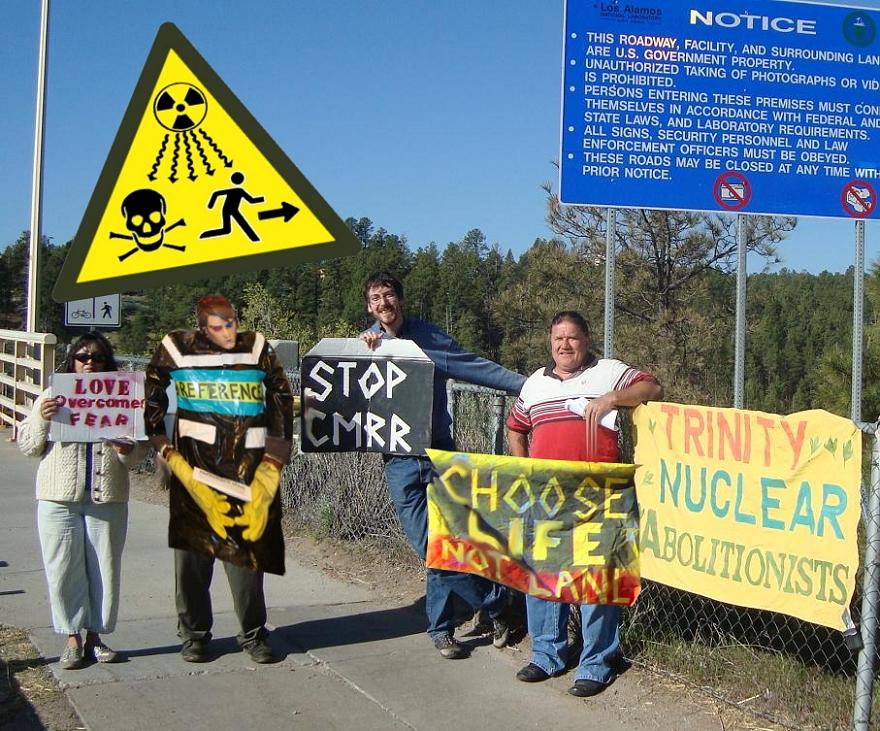We become what we behold. We shape our tools and then our tools shape us.
--Marshall McLuhan

Jim Emerson's analysis of Let Me In.
REAL kids and Los Alamos scientists in 1985
Reference Man at Los Alamos Hospital
TNA leaves LANL for LLNL

Art at its most significant is a Distant Early Warning System that can always be relied on to tell the old culture what is beginning to happen to it.
--Marshall McLuhan
|
JANUARY, 2014; Cyberspace, USA
Let Me In is not merely a horror movie, it's a genre i call, "American Terrorist Art-Therapy."
I think that most audiences see the bullying of mid-school students as the most realistic horror in the movie. Something we know happens to kids--such simple, brutal terrorism--was as scary in the film as it is real in this world. That kind of regular real violence is counterbalanced with a modern audience's non-suspension of disbelief over the supernatural powers of the blood-sucking girl. But an unreal human-esque serious need for human blood is as horrifically unreal to us as nuclear weapons would be unreal to our ancestors. If Manhattan project scientists 70 years ago could have seen the spectacle of Let Me In (with all of it's 21st century computer-generated graphical brilliance), then the insanity of unreal vampire violence might have the verisimilitude of totally real nuclear violence in the modern world. The fearful evil of nuclear bombs to average Americans 50 years ago is still as horrible of a reality as bullies are at schools today.
US Americans of the 21st century tend to be unafraid of nuclear weapons and the specter of nuclear bomb detonations, because the evil of nuclearism has successfully led this generation into sacrificing others to the nuclear god. Our people have succumbed to the servitude of nuclearism; we serve the spiritual vampire constantly sucking new souls into the system. In other words, the man and boy guilty of violence to help the fictitious character named "Abby" to live and thrive only by human blood sacrifice is identical to average American tax-paying support of the war-machine and the nuclear weapons establishment. It's the servitude of what Hannah Arendt called the banality of evil. Navajo and other Native American miners came to early deaths due to uranium mining for this establishment, people down-wind of nuclear testing in the 20th century lost their lives via cancers and leukemias, and the sucking of resources for nuclear weapons in Los Alamos (and elsewhere) means fewer resources (ergo therefore violence and death) for impoverished folks needing health-care, housing, and decent food. That's real, and harder to visualize than a simple, brutal on-the-spot murder. It's so very obvious, and allegorically more obvious in this movie which neither mentions "vampire" nor "nuclear", yet we all know what kind of sick violence is happening in the story--not just the bullies carrying on the cycle of violence, but the (SPOILER ALERT...) changing of the guard as the old generation passes, for a new generation to feed the beloved blood-sucker, simply because its a childish altruism.
The audience spends time with the characters who are caught in the cycle of violence, and we identify with the trap of forsaking humanity and ordinary healthy virtues on behalf of honoring a single virtue--helping one apparently worthy entity (Abby) to continue. It's like the real-world Los Alamos ethic of helping the entity of "localism," or employment in nuclearism, to continue at the expense of more commonsense virtues (the common good, less violence, environmental justice, restorative justice, etc.)
This film excellently shows the goodness of evil--it's film noir at its apex. We know film noir was an art-therapy coming from the conscience of America right after the first nuclear bombs were detonated with no public, governmental or scientist-based apology forthcoming to acknowledge the unnecessary cruelty to Japan. We know the nuclear terrorism has been non-stop and the victims go largely unnoticed (like a bullied child in school unable to communicate with disconnected parents unable to help the child). We know film noir was dark with heroes and anti-heroes, and wet cities, so this film has FROZEN scenes to show how wet the wetness has gotten in the USA at the epitome of our anthropological contribution to human history. There is no apology to victims and no redemption in this filmic story, neither is there apology from Los Alamos or redemption for the life-sucking scientists, bureaucrats and engineers in the current nuclear era, until the monster is dismantled. Catholic Workers know that "the only solution is love", and that includes the loving self-sacrifice coming from the terrorists (including scientists, bureaucrats and engineers) who INDIVIDUALLY still have a chance to renounce their violence and nuclear terrorism.
In the film, that means an end to the so-called-life of Abby--so it doesn't happen, because that wouldn't be a "good" ending to this dramatic story of ongoing evil. The point is we (and the newly recruited boy-child, "Owen," former victim) are attracted to the lure of technical prowess in nuclearism (or purpose and camaraderie/solidarity with vampires) and humans get trapped in that arena. In reality, a few heroic folks DO TRY to shine lights on the sinister crimes against humanity and crimes against the environment. A few heroic folks do quit their jobs at the nuclear labs, because they care about resolving the cognitive dissonance rampant in the town of Los Alamos.
The sequel (rather, the lesson we learn in this country) is easy and nonviolent: Abby should VOLUNTARILY let sunlight touch her skin, and then suffer briefly in order to no-longer need others to murder and suffer on her behalf. In our world, the nuclear scientists need to give up the ghost, cease the worship of deathly tools, let the economy suffer while humanity regains its composure and our society can instead be based on service to the under-priviledged. Los Alamos has the richest per-capita income rate in the USA, so Catholics, who understand the Christ-like preferential option for the poor folks, should understand clearly that evil resides in Los Alamos. And personal experience as well as film noir lessons show that evil resides alongside of good. The violence of nuclearism and vampires is enabled by good people with good intentions and a very privileged/selfish focus.
|
ANOTHER SUPER-CLEAR ANALOGY OF THE SYMBOLICHARACTERS:
Abby = Nuclear Weapons Establishment and Facilities, Los Alamos National Lab itself
Owen & 'the Father' = Department of Energy, National Nuclear Security Administration, etc.
Policeman/Detective = Pro-Nuclear agencies such as the US Government, the Nuclear Regulatory Commission, etc.
Bullies = Legal system and its enforcers--i.e. Pro-Force, Wackenhuts, Los Alamos Courts, Federal Courts, Jails & Prisons, etc.
Owen's Parents = US American public, consuming violence daily, apparently disagreeing on the nature of evil
Who Is REFERENCE MAN?
According to the International Commission on Radiological Protection's 1974 definition of Reference Man:
“Reference Man is defined as being between 20-30 years of age, weighing 70 kg, is 170 cm in height, and lives in a climate with an average temperature of from 10o to 20oC. He is a Caucasian and is a Western European or North American in habitat and custom.”
According to Wikipedia, Reference Woman and Reference Child have been developed as well. In the field of nuclear science, there is a place for this Reference Family, that is, for all radiological data to be placed in the context of Reference Woman, Reference Child, and Reference Man. In the past, much data has only been placed in the context of Reference Man.
However, in the field of an actual nuclear blast (that is, if you stand within a few meters of the next explosion of a nuclear weapon) when the purpose of a real nuclear weapon is realized, all members of the Reference Family are irrelevant, because they are completely dead, vaporized by the heat and blast, so the radiological absorption capacities are impossible when the matter has been turned into a state of poison fire.
Did Reference Man Survive His Own Funeral?

What On Earth is the CMRR?
Simply stated, it's a multi-functional plutonium pit factory, which does the work Rocky Flats used to do.
LASG's Reasons to Delay the CMRR
The Panel Discussion in Los Alamos about the CMRR
CMRR-NF "Supplemental Environmental Impact Statement"
CMRR-NF = BAD news! 27 April 2010
LANL Fathers Day 5 Won't Pay Court; Will Pay TWU
The flier we distribute to employees and other adults in the area
|


